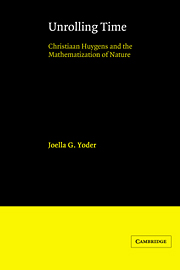2 - Accelerated motion: gravity
Published online by Cambridge University Press: 07 December 2009
Summary
Christiaan Huygens's superior abilities in mathematics and mechanics were already evident in 1646, when he was but seventeen years old. Two examples of his scientific maturity are particularly significant for his future development. The first is a study of the catenary, which Huygens most likely undertook after having read Albert Girard's annotated edition of Simon Stevin's mathematical works, one of the books recommended to Huygens by his teacher as worthy of study. In this work, Girard erroneously claims that the curve formed by a chain hung from both ends, called the catenary, is a parabola. By viewing the hanging chain as a discrete set of equal weights distributed uniformly along a parabola, Huygens was able to disprove Girard's claim.
At about the same time, Huygens undertook the study of a work by Juan Caramuel Lobcowitz, who claimed that the distances traversed by a falling body are proportional to the times elapsed. Huygens refuted Lobcowitz's claim, showing by means of an arithmetic progression that, instead, the spaces are proportional to the squares of the times. In a letter dated September 3, 1646, he boasts to his brother of his discovery, also claiming he can prove that, if the body is projected to one side instead of straight down, it will describe a parabola as it falls: “Of all this and infinitely more things that depend on it I have never known a demonstration before that of the discoverer, myself.” In a postscript the proud discoverer suggests that his brother show the letter to their father.
- Type
- Chapter
- Information
- Unrolling TimeChristiaan Huygens and the Mathematization of Nature, pp. 9 - 15Publisher: Cambridge University PressPrint publication year: 1989



